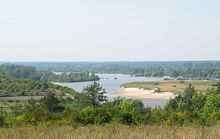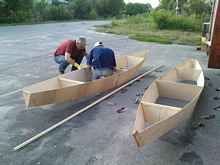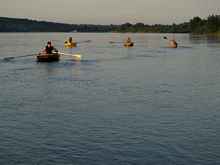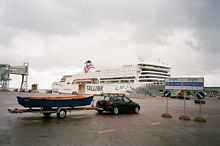Instant boat means a boat which has been built
with no jigs and lofting. It takes the shape simply because of
joining the panels. So an instant boatbuilding workshop means
no need for special place to build boats. It runs simply because
a couple of guys met together and decided to go ahead. Even on
the street. Such thing has happened to me this summer.
But first let’s get back a bit. Last winter a group of
friends started a foundation called “Na Dobre” here
in Warsaw. Here is a brief description of the mission:
The Dobre village is located in the area still forgotten by mass
tourism, people use to work hard on their hop and raspberry plants
(and to ignore their river of course). I’ve been invited
to be a member of the council board, because of few adventures
I had thanks to Jim Michalak designed boats. I appreciated it
because I've got a good opportunity to share my experience and
joy of boating and instant boats with more people. I decided to
run the boatbuilding class, to try to get local kids interested
in boating on local rivers. On the other hand, our goal was to
get city people interested to come there and spend some time in
this forgotten area not harming local balance.
I started to prepare the concept, made a choice of boats, wrote
the schedule and budget. My obvious focus was on Jim Michalak
designs, because I’m familiar with them, and – what’s
more important – I’m sure they offer perfect characteristics
for their purpose. Primarily the workshop formula was wide open
including families with kids etc, every evening lectures, and
a 9 day course, but once we finished the draft with 3 young guys,
I decided to change it into really extensive job to check how
quick one can row his boat once he started the construction. To
be honest I was happy of that because it might make my Warsaw
preparations for my Raid Finland 2009 trip 1-2 days longer than
planned, what was 2-3 days anyway. It’s an advantage in
my workplace to get summer holiday time as long as possible, thus
two events one directly after another.
What was original in the workshop formula I believe – a
possibility to keep a boat at the place after the workshop. I
think the most typical reason which stops city people from building
own boats is lack of space to store a boat in a city life reality.
So the foundation offered a room to store built boats in the beautiful
boating area, located not so far from few big and middle cities,
all year round.
As the foundation public image is based on association with the
Good village name, I called the project ”LET’S BUILD
GOOD BOATS!”
The place for the class was finally Zmijowiska village, close
to Dobre village, because the village volunteer-firefighter section
offered their garage for the event. We were really happy with
that: there was a big room inside (usually used as a dancing hall
for weddings or as a conference hall for village meetings) for
clean works and the actual garage (usually used to keep the firefighters
car in) for dirty works. There was a nice public space on the
street in front of the building to relax too. There was a little
food and drink store on the corner so local people were frequent
guests there.
 |
The place for the class was finally Zmijowiska
village, close to Dobre village, because the village volunteer-firefighter
section offered their garage for the event. |
Finally the students were Tomek and Jacek, 2 Warsaw guys, and
Kamil, a local farmer, hired by the foundation to build a piragua.
Of course anybody else was welcome to come, see, touch, discuss
and everything. Every student had to bring his own lifejacket,
a pair of oars and 5 meters of a mooring rope. The foundation
collected 600 zlotys (about 200 USD) per boat for materials. The
tools were just personal, mine and Tomek’s. Not many tools
in fact: 2 jigsaws, 2 electric drills/screwdrivers, and 1 table
saw.
The final choice were 2 Robotes
(by Tomek and Jacek) and 1 Piragua
(by Kamil). I decided to build another Piragua for the Foundation
myself.
So we ‘ve bought 10 sheets of 6 mm plywood, 100 meters
of pine 4x2 cm sticks, 6 kg of epoxy, so called “winter
hardener” according to epoxy amount, glass tapes, screws
and packed it all onto my trailer, put my Robote type “Flaneuse”
on and set off from Warsaw to Zmijowiska (120 km) on the Friday
afternoon. Tomek was supporting me taking small stuff by his car.
Saturday morning Jacek – our “last minute”
guy - arrived, and we started. The job went really quick. You
can just observe it in the Flickr report linked here:
https://www.flickr.com/photos/10196268@N05/sets/72157621910577413/
Thus, I’ll give only few comments. So, we faced two critical
moments during that project. First – we didn't have enough
clamps. 80 of them were in use permanently, and because Robote
boats were build by future owners, they had the priority. Piraguas
had to stay on the second line so I decided to concentrate efforts
on Kamil’s piragua – mine was at the end. So she hasn’t
been finished with the impregnation and did not touch the water
together with other boats. Second – not enough epoxy. I
had to drive to Warsaw to get more. The reason was that winter
hardener was curing very fast, and less skilled students were
not fast enough to use all the prepared portion. On the other
hand, we did make very quick step by step progress.
 |
Late afternoons, trying to catch last daylight,
we used to carry piraguas outside and work on the street. |
It turned out that taking a finished boat there was very useful,
because students were able to check immediately what any part
is made for, how it sits in the real boat and so on. Finally,
it turned out that 200 USD in Polish in reality is enough to get
perfectly designed hull made of plywood. A lifejacket, and ready
made oars bought in a marine store oars make another 200 USD.
We have finished 1 a.m. on Thursday, packed our stuff to the
cars, and set out into a foggy night ride back to Warsaw. The
boats, wet of epoxy lacquer, were left till Saturday under Kamil’s
care.
 |
After lunch they all launched their boats. |
The end of the project – most exciting I think– played
out without me. Thinking on the workshop in the wintertime, I
decided that ready boats should be launched and tested by owners
– but a brief river practice will be necessary. I asked
my friend Pawel who is an experienced yacht skipper to run such
little but important event for the foundation. He’d agreed
and prepared his own project: 4 hour long lecture on river phenomenas,
river navigation, safety and knotting practice. So the Warsaw
students came back to Zmijowska on Friday afternoon and painted
their Robotes with quick dry paint. After Saturday breakfast they
met their new instructor – Pawel - and listened to his lecture,
and after lunch they all launched their boats (my Flaneuse became
the new instructor’s ship). Then they had a very nice trip
down the small river Chodelka, next entered the big and beautiful
Wisla river and finished in Kazimierz on the Wisla, leaving about
15 km behind. They told me they had a really GOOD time!
 |
That time I was on my 1000 km long way to Finland,
screwing cleats, blocks etc. to my sailboat hull during very
few short stops... |
Best regards from Poland.
Wojtek Baginski
Photos by Wojtek Holnicki, Rafal Szambelan, Tomek Ziembinski,
and author.
Related links:
Flaneuse, crossing the Wisla delta 2007:
https://www.duckworksmagazine.com/08/outings/wisla/index.htm
Flaneuse, crossing the Warsaw city 2009:
https://rowingforpleasure.blogspot.com/2009/03/rowing-in-poland.html

***** |

